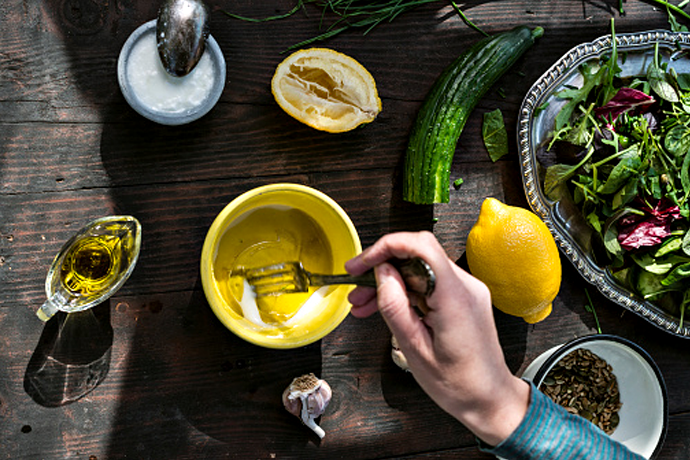
Every so often, you come across a curious piece of menu jargon. It sounds familiar. It looks familiar.
Maybe you’ve even consumed it a time or two. But what the heck is it, really? Great question.
Sounds like a job for The Interpreter.
The word: Emulsion (eh-mull-shun).
Its origin: The Latin verb “emulgere,” which translates roughly to “milk out.” It’s not as icky as it sounds.
What it is: A fine dispersion of minute droplets of one liquid in another in which it is not soluble or miscible.
What it really is: A mixture of two liquids that aren’t chemically fated to be mixed together.
What it really, really is: Mayonnaise. Probably.
The scientific explanation for that blatant generalization: In cooking terms, an emulsion almost always refers to a combination of fat and water. A vinaigrette (oil and vinegar) is an emulsion. Mayo (lemon juice and oil) is also an emulsion, but it’s stable: egg yolks are added to act as an “emulsifier,” i.e., the property holding together our two immiscible liquids. Props to egg yolks.
Where you’ve seen it: Boutique steakhouses; Brooklyn; beguiling small children on MasterChef Junior.
The way it appears on a menu: Usually following the descriptor making that particular emulsion unique, like “chorizo” or “champagne” or “raison.”
Why it’s not as fancy-pants as it sounds: Those sorts of emulsions are often just a mayonnaise or vinaigrette to which the unique ingredient has been added, perhaps with the aid of a food processor.
How to use this knowledge to your advantage: 1) Buy your favorite aioli; 2) pour it out into a bowl; 3) serve alongside steak or pork or whatever at your next dinner party; 4) nonchalantly ask one of your guests to pass the “garlic emulsion”; 5) calmly go about your business, as if you didn’t just drop the word “emulsion” into casual dinner conversation.
Sounds like a job for The Interpreter.
The word: Emulsion (eh-mull-shun).
Its origin: The Latin verb “emulgere,” which translates roughly to “milk out.” It’s not as icky as it sounds.
What it is: A fine dispersion of minute droplets of one liquid in another in which it is not soluble or miscible.
What it really is: A mixture of two liquids that aren’t chemically fated to be mixed together.
What it really, really is: Mayonnaise. Probably.
The scientific explanation for that blatant generalization: In cooking terms, an emulsion almost always refers to a combination of fat and water. A vinaigrette (oil and vinegar) is an emulsion. Mayo (lemon juice and oil) is also an emulsion, but it’s stable: egg yolks are added to act as an “emulsifier,” i.e., the property holding together our two immiscible liquids. Props to egg yolks.
Where you’ve seen it: Boutique steakhouses; Brooklyn; beguiling small children on MasterChef Junior.
The way it appears on a menu: Usually following the descriptor making that particular emulsion unique, like “chorizo” or “champagne” or “raison.”
Why it’s not as fancy-pants as it sounds: Those sorts of emulsions are often just a mayonnaise or vinaigrette to which the unique ingredient has been added, perhaps with the aid of a food processor.
How to use this knowledge to your advantage: 1) Buy your favorite aioli; 2) pour it out into a bowl; 3) serve alongside steak or pork or whatever at your next dinner party; 4) nonchalantly ask one of your guests to pass the “garlic emulsion”; 5) calmly go about your business, as if you didn’t just drop the word “emulsion” into casual dinner conversation.
